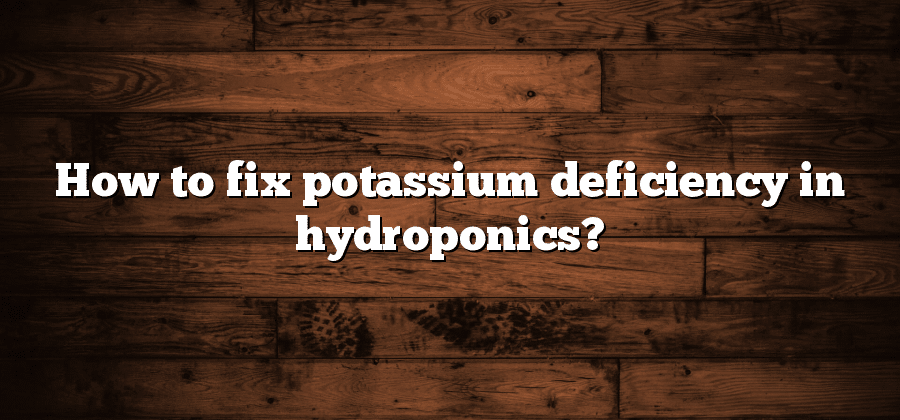Understanding Potassium Deficiency
Potassium deficiency is a common issue that hydroponic gardeners may encounter in their plants. This essential macronutrient plays a crucial role in various physiological processes, including photosynthesis, water regulation, and nutrient uptake. When plants lack sufficient potassium, they can exhibit a range of symptoms that may negatively impact growth and overall plant health.
One of the most recognizable symptoms of potassium deficiency is chlorosis, which refers to the yellowing of leaves. This discoloration typically starts at the leaf margins and progresses towards the center, giving the leaves a burnt appearance. In addition to chlorosis, plants deficient in potassium may also display stunted growth, weak stems, and reduced fruit production. It is important for hydroponic growers to understand these symptoms in order to address potassium deficiencies promptly and efficiently.
Recognizing Symptoms in Hydroponic Plants
Symptoms of nutrient deficiency in hydroponic plants can be an indication of underlying potassium issues. Without sufficient levels of potassium, plants may struggle to maintain healthy growth and development. As a hydroponic gardener, it is crucial to familiarize yourself with the telltale signs of potassium deficiency in order to address the problem in a timely manner.
One common symptom of potassium deficiency is spotting on the leaves, typically appearing as small, necrotic patches. These spots may start off as pale yellow or brown, then gradually turn to dark brown or black. Another noticeable sign is leaf yellowing, particularly along the margins or in between the veins. Additionally, potassium-deficient plants often exhibit stunted growth, with shorter stems and smaller fruits or flowers. By observing these symptoms and taking appropriate action, hydroponic growers can ensure optimal health and productivity in their plants.
Analyzing Nutrient Solution pH Levels
One crucial aspect of maintaining optimal conditions in a hydroponic system is analyzing the pH levels of the nutrient solution. The pH level refers to the acidity or alkalinity of the solution and plays a significant role in nutrient availability and overall plant health. Monitoring and adjusting the pH level is essential to ensure that plants can effectively absorb essential nutrients and thrive in a hydroponic environment.
When analyzing nutrient solution pH levels, it is important to aim for a specific target range that is optimal for the particular plants being grown. Most hydroponic crops prefer a slightly acidic environment with a pH level between 5.5 and 6.5. This range is considered ideal as it promotes nutrient uptake while preventing nutrient deficiencies or toxicities. Regular monitoring of the pH level is necessary as fluctuations can occur due to various factors, such as nutrient uptake, water quality, and the addition of supplements or additives. By maintaining the nutrient solution’s pH within the appropriate range, growers can ensure that their hydroponic plants receive the necessary nutrients for healthy growth and maximum yield.
Evaluating the Role of Potassium in Plant Growth
Potassium is an essential element for plant growth and development. It plays a crucial role in various physiological processes, making it vital for overall plant health. One of the primary functions of potassium is its involvement in photosynthesis, the process by which plants convert light energy into chemical energy. Potassium is an essential component of the enzyme responsible for the synthesis of adenosine triphosphate (ATP), which is the primary source of energy for plant cells. In addition to its role in photosynthesis, potassium also regulates the opening and closing of stomata, the tiny pores on the surface of leaves that allow for the exchange of gases. This regulation directly affects the plant’s ability to efficiently use water, as well as its overall water balance. Furthermore, potassium is involved in the activation of several enzymes that are crucial for various metabolic processes, including protein synthesis and carbohydrate metabolism. Overall, the role of potassium in plant growth is undeniable, and its deficiency can have significant negative impacts on plant development and yield.
Optimizing Potassium Uptake in Hydroponic Systems
Hydroponic systems rely heavily on nutrient solutions to provide plants with the necessary elements for optimal growth. Among these essential nutrients, potassium plays a crucial role in various physiological processes. It is responsible for regulating water balance, activating enzymes, and facilitating the transportation of nutrients within the plant. Hence, optimizing potassium uptake is vital to ensure the health and productivity of hydroponic plants.
The first step towards optimizing potassium uptake in hydroponic systems is to maintain the nutrient solution at the appropriate concentration. High potassium levels can lead to nutrient imbalances and can harm plant growth, while low levels can result in potassium deficiency. Regularly monitoring and adjusting the nutrient solution’s potassium content can help maintain an optimal concentration that meets the specific needs of the plants being grown. Additionally, ensuring a balanced nutrient composition, including other essential elements, is critical for proper potassium uptake. By providing a well-rounded nutrient solution, hydroponic growers can promote efficient potassium absorption and utilization, enhancing overall plant health and yield.






